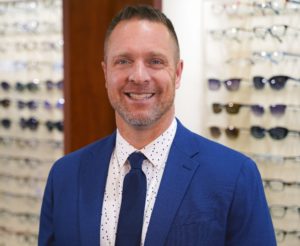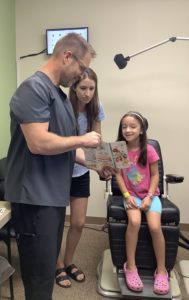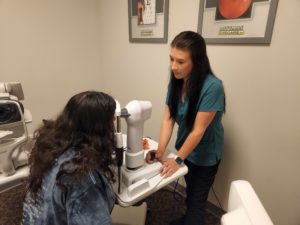September 1, 2022
By Michael Dittman, OD
Referrals may not come overnight, but if you stay consistent and follow this step-by-step process, we hopefully can help more kids become less myopic and make a difference in this battle.
Recently, I have faced the most formidable challenge in my 20-year optometry career. How do you help other providers shift their thinking to the fact that myopia is a disease? How do you get them to treat it proactively or refer to a practice specializing in myopia control? In my experience, I’ve noticed that forming these relationships with the intent of referrals can be a bit exhausting.
The following steps have helped me start to see the light at the end of the tunnel and make a more significant impact in the world of myopia management.
Become an Expert
The first step is to become an expert on myopia. There has never been a better time to learn about myopia. There are so many resources out there, and with a bit of motivation and hard work, everyone can become a myopia expert. These resources include printed materials, such as the new book Managing Myopia One Child At A Time by the group at Université de Montréal, online journals such as Review of Myopia Management, and websites such as Myopia Profile and the Brien Holden Vision Institute. Vision By Design is a myopia-focused meeting held annually with a “Bootcamp” designed to help doctors with limited experience treating myopia.
To help the referring doctors and interested parents look at us as experts, we went to work on making the Myopia Matters Club at Dittman Eyecare a truly separate branch of our office. The Myopia Matters Club started in our office to educate parents about myopia management and keep communication open for all patients about myopia treatment options. Since starting it, we’ve created custom brochures and business cards with a different logo from our established practice materials. We also have taken it one step further and started a separate website, which has a myopia assessment for parents and is a way doctors can refer patients to our office without a phone call. I do not think it is necessary to do this to manage myopia, but I believe these steps have made us stand out and allowed more doctors and patients to find us for care.
Then, you must ensure that your office has processes to treat kids for myopia. This starts with staff training. I educated all staff members on the basics of myopia management and then chose one person in our office as the “Myopia Matters Club Coordinator.” Sabrina Moreton became an expert in our scheduling process, contract details, and answering questions frequently asked by other providers or interested parents. She is the contact for all referring offices, and since we established her position, we have seen a large uptick in the number of myopia cases we are actively managing.
Time to Network
Once you have everything in place, it is time to network!
STEP 1: The Introductory Letter
The first step in this process is to send a letter to all the desired referral services, such as other optometry and ophthalmology practices or local pediatricians. In this introductory letter, I include these key points:
- Background on myopia, including the effects of not managing myopia
- The options available to manage myopia
- A section on knowledge and experience
- The tools our program has in place to help the referring providers
- My contact information, including email and cell phone number
STEP 2: Follow-Up Phone Call
Approximately two to three weeks after the letter is sent, a follow-up phone call to the providers’ offices is recommended. This phone call can be made by the managing provider or a key team member, such as a coordinator, who has moderate knowledge about the management program. A script or list of talking points can be beneficial to make sure the call is productive. Getting the provider on the phone is ideal, but a lead technician or nurse within their office can be just as helpful. The critical points that we include in this introductory call are the following:
- Confirm the letter was received (if not, offer to send another via email or fax)
- Ask if they have any questions about the program itself
- Inquire if they desire any materials (business cards, brochures, etc.)
- Offer assistance if they feel they have a child that we can help
- Attempt to find some available times over the next month for a short in-person meeting with the target referring provider
STEP 3: In-Person Introduction
This is the most difficult step for some of us, but it may also be the most important in building the referral network. Referring providers hope that their patients are cared for properly. Having a personal relationship helps with this immensely. Before the meeting, a team member calls to confirm the approximate time the provider will have for the introduction and asks how many staff members will be working. It is of the utmost importance to respect the referring providers’ time and understand that we are a guest in their practice. Here is a list of things to bring or be ready to discuss:
- Printed materials – business cards, brochures, a few studies about myopia management or the secondary diseases of myopia
- Target market (myopic kids under age 15)
- Treats for the office. Building a relationship with the referring doctors’ office team is vital, and everyone loves gifts.
- Offer a more in-depth follow-up meeting, such as a lunch, to discuss further
STEP 4: Stay Consistent with Repeating Steps 1-3
As providers, we hope to return to our practice and get referrals the next day. Although this may happen, it is improbable. You cannot be discouraged by this not happening; instead, stay consistent with networking. This will hopefully keep us fresh on the provider’s list so they will consider our program when they have a young myopic child. At the same time, we do not want to sour the relationship with the providers. My ideal schedule (and yes, I struggle with consistency, too) is to try to send a letter or make an in-person visit every six weeks.
Don’t Get Discouraged
Change is hard, especially when attempting to get other providers to change their thinking about myopic kids. Referrals may not come overnight, but if you stay consistent and follow this step-by-step process, we hopefully can help more kids become less myopic and make a difference in this battle.
 |
Michael Dittman, OD, is the president and owner of Dittman Eyecare. He started the practice in 2003 with one doctor and two staff members, and the practice has grown to currently having four doctors, 25 team members, and three locations north of Pittsburgh. Dr. Dittman also recently founded The Myopia Matters Club, which is a separate branch of the office solely focused on myopia management services for children who are myopic or high risk to become myopic. |















